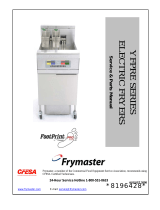
YSCFC SERIES FLATBOTTOM GAS FRYERS
CHAPTER 1: SERVICE PROCEDURES
1-5
Non-CE Electronic Ignition
Valve
5. To adjust burner gas pressure, remove the cap from the gas valve
regulator and adjust to correct pressure (arrow shown at right).
6. Place the fryer power switch and the gas valve in the "OFF"
position. Remove the pressure-measuring device fitting from
the pressure tap hole and reinstall the pressure tap plug.
1.5 Calibrating the Thermatron Temperature
Controller
1. Ensure the fryer ON/OFF switch is in the "OFF" position. Fill the
frypot to the proper oil-level line with cooking oil/shortening. If
solid shortening is used, ensure that the shortening is properly
packed and melted in the frypot before proceeding.
2. Place the fryer ON/OFF switch in the "ON" position. Set the Thermatron dial to 325°F (162°C).
3. Allow the oil/shortening to stabilize at setpoint temperature. This is evident when the burners
have cycled on and off several times.
4. Insert a thermometer or pyrometer into the frypot within ½ inch (1.25 cm) of the probe tip.
Ensure the tip of the thermometer/pyrometer does not touch the bottom or sides of the frypot.
5. If the temperature on the thermometer is
higher or lower than 325°F (162°C), the
dial is out of calibration.
6. Calibrate the dial by first loosening two
setscrews in the dial (arrows). After loosening
both setscrews, slowly turn the dial to match
the temperature reading of the thermometer.
Tighten each setscrew, ensuring the dial does
not move on the shaft during tightening.
7. Allow burners to cycle on and off several
times, then recheck oil temperature as
described in step #5. If the Thermatron
dial temperature matches the thermometer
temperature, the controller is calibrated.
If not, repeat step #7.
8. After calibration is complete, place the fryer
power switch in the "OFF" position and
disconnect the fryer from the electrical supply.
Loosen two setscrews in dial (arrows) to recalibrate
controller.




























